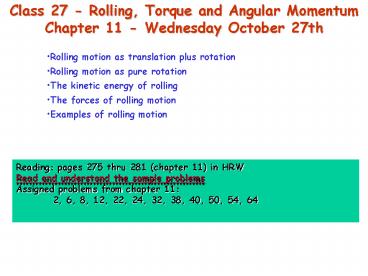Class 27 Rolling, Torque and Angular Momentum - PowerPoint PPT Presentation
1 / 12
Title:
Class 27 Rolling, Torque and Angular Momentum
Description:
Reading: pages 275 thru 281 (chapter 11) in HRW. Read and ... 2, 6, 8, 12, 22, 24, 32, 38, 40, 50, 54, 64. Rolling motion as translation plus rotation ... – PowerPoint PPT presentation
Number of Views:138
Avg rating:3.0/5.0
Title: Class 27 Rolling, Torque and Angular Momentum
1
Class 27 - Rolling, Torque and Angular
Momentum Chapter 11 - Wednesday October 27th
- Rolling motion as translation plus rotation
- Rolling motion as pure rotation
- The kinetic energy of rolling
- The forces of rolling motion
- Examples of rolling motion
Reading pages 275 thru 281 (chapter 11) in
HRW Read and understand the sample
problems Assigned problems from chapter 11 2,
6, 8, 12, 22, 24, 32, 38, 40, 50, 54, 64
2
Rolling motion as rotation and translation
The wheel moves with speed ds/dt
3
Rolling motion as rotation and translation
The wheel moves with speed ds/dt
Another way to visualize the motion
4
Rolling motion as pure rotation
5
The forces of rolling (role of friction)
- If the c.o.m. moves with constant velocity, and
the wheel rotates with constant angular speed w
vcom/R, then there are no net forces on the wheel.
- If however, the wheel has an angular
acceleration, then there must be a frictional
force at P in order for the wheel to move.
6
The forces of rolling (role of friction)
- If the c.o.m. moves with constant velocity, and
the wheel rotates with constant angular speed w
vcom/R, then there are no net forces on the wheel.
- If however, the wheel has an angular
acceleration, then there must be a frictional
force at P in order for the wheel to move.
- If the driving mechanism is a linear force, e.g.
someone pushing the wheel through its center of
mass, then the frictional force opposes the
pushing force. - The sum of the two forces provide the linear
acceleration. - One can also attribute the angular acceleration
to the fact that Fpush has a moment arm about the
point where the wheel makes contact with the road.
7
The forces of rolling (role of friction)
- If the c.o.m. moves with constant velocity, and
the wheel rotates with constant angular speed w
vcom/R, then there are no net forces on the wheel.
- If however, the wheel has an angular
acceleration, then there must be a frictional
force at P in order for the wheel to move.
- If, on the other hand, the driving mechanism is
rotational, i.e. due to the torque of a motor,
then the frictional force is in the opposite
direction, and it causes the linear acceleration.
8
Rolling down a ramp
- The frictional force is essential for the rolling
motion. - If one analyzes the motion about the center of
the disk, fs is the only force with a moment arm.
9
Rolling down a ramp
- However, we do not really have to compute fs (see
section 12-3). - We can, instead, analyze the motion about P, in
which case, Fgsinq is the only force component
with a moment arm about P.
10
Some rotational inertia
11
More on rolling
This is the same as for the frictionless incline
(acom g sinq) with the additional Icom/MR2 term
in the denominator.
12
More on rolling
- The Yo-yo is essentially the same as the disc
rolling down the incline, except that the string
plays the role of the slope and the tension in
the string plays the role of the friction. - Thus, q 90o, and the relevant radius is Ro.
- However, one should use R when calculating Icom.































